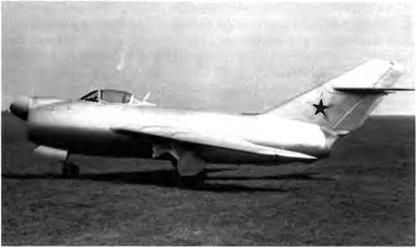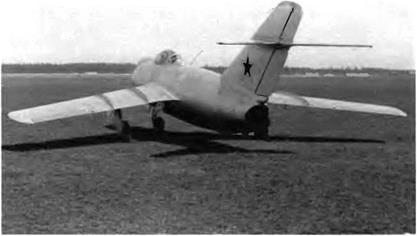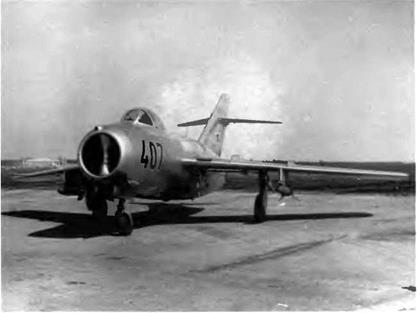MHM5P bis / SP-1
The development of an all-weather fighter for the PVO had become a necessity. When the first Soviet airborne radars appeared at the end of the 1940s, it was decided that the MiG-15 bis would receive this advanced equipment. But first a number of questions had to be answered regarding the capabilities and efficiency of both the radar control unit when engaging enemy aircraft and the sighting system in blind flying (at night or in clouds).
The council of ministers called for development work on both the airborne radar and the aircraft on 7 December 1948. The first ranging
|
Installation of the Toriy radar on the MiG-15P bis necessitated alteration of the fuselage nose structure up to the no. 8 frame |
radar, the Toriy, was developed by A. B. Slepushkin, pioneer of Soviet radar technology. It was a peculiar system: its one antenna both transmitted and received signals. It was housed in a small radome made of a specially developed dielectric material. The Toriy was not easy for the pilot to control while trying to intercept enemy aircraft because it could not track targets automatically.
From the start MiG OKB engineers were determined not to let the efficiency and performance of the MiG-15 bis suffer because of the addition of radar. Production MiG-15 bis no. 3810102 built at factory no 1 was sent to the OKB workshop and modified, becoming the SP-1. The two guns on the left of the fuselage were removed; only the N-37D with forty-five rounds was retained. The ASP-3N gunsight was replaced by a new model, and the S-13 camera gun usually placed above the air intake was moved to the right side of the fuselage. Most important, a radar display was set into the instrument panel. With that display the pilot was able to track an invader, bring his aircraft into line with it, and measure its distance before firing.
As it turned out, many other modifications had to be made, mainly structural ones:
—because of the radar installation and armament removal, the fuselage nose section was made over up to the no. 8 frame and lengthened by 120 mm (4.7 inches)
—the area of the airbrakes was increased, and their shape and axis of rotation were altered (22 degrees in relation to the vertical)
—the cockpit windshield was fitted with 64-mm-thick bulletproof glass, and the shape of the windshield and the canopy was changed in order to retain a good forward view despite the nose modifications
—the wing anhedral was increased from 2 to 3 degrees —the front leg of the landing gear had to be moved 80 mm (3.5 inches) forward to bring the NR-37 cannon axis as close as possible to the aircraft datum line
—the wheel fork was replaced by a half-fork, and the double gear doors were replaced by a single door —the elevator control was fitted with a BU-1 servo-control unit
The SP-1 prototype was equipped with an ARK-5 automatic direction finder and an MRP-48 marker receiver. After the factory flight tests conducted in December 1949 by A. N. Chernoburov and G. A. Sedov, the aircraft was transferred to the Nil WS on 31 January 1950 for its state trials. They ended on 20 May 1950.
The test report noted a number of defects. The pitching stability was too scanty at landing, and compared with the MiG-15 (SV) the dynamic stability margin had decreased. In straight level flight, the aircraft tended to bank to the left and then side-slip at 940-950 km/h (508-513 kt) Poor aileron efficiency limited the bank angle to 5 degrees.
The report concluded that the SP-1 could not be used as an all – weather interceptor because its Toriy ranging radar did not work properly. The all-weather radar tests were conducted by Suprun, Kalachev, Pibulyenko, Blagoveshchenkiy, Antipov, Dzyuba, and Ivanov, all military pilots. Several passes were made in attempts to locate 11-28 and Tu-4 bombers. The SP-1 was not certified because it was too difficult for a pilot to fly his aircraft and operate the radar at the same time—and moreover, the Toriy was not very reliable. Its manufacturer upgraded the unit, which then became known as the Toriy A and was installed on the MiG-17 (SP-2). But its most serious shortcoming was not addressed: the Toriy A still could only track incoming aircraft manually.
In 1951 five SP-ls equipped with RP-1M radars were assembled at factory no. 1. On 25 November one was sent to the Nil WS for trials, but the aircraft and its upgraded radar unit still failed to earn certification. Like the MiG-15 bis, the MiG-15P bis (SP-1) was powered by a 2,645-daN (2,700-kg st) VK-1 turbojet.
Specifications
Span, 10.085 m (33 ft 1 in); overall length, 10.222 m (33 ft 6.5 in); wheel track, 3.852 m (12 ft 7.6 in); wheel base, 3.075 m (10 ft 1.1 in);
|
|
On the MiG-15P bis the two NR-23 cannons usually found at the lower left of the MiG – 15 bis front fuselage had to be removed.
|
|
The wing anhedral of the MiG-15P bis was increased slightly, as was the area of the airbrakes.
|
The SD-21 was a MiG-15 bis used for testing S-21 rockets, hence its designation. |
wing area, 20.6 m2 (221.7 sq ft); empty weight, 3,760 kg (8,287 lb); takeoff weight, 5,080 kg (11,196 lb); fuel, 1,168 kg (2,574 lb); wing loading, 246.6 kg/m2 (50.55 lb/sq ft).
Performance
Max speed, 1,022 km/h at 5,000 m (552 kt at 16,400 ft); 979 km/h at 10,000 m (529 kt at 32,800 ft); climb to 5,000 m (16,400 ft) in 2.15 min; to 10,000 m (32,800 ft) in 5.35 min; service ceiling, 14,700 m (48,200 ft); range, 1,115 km at 10,000 m (692 mi at 32,800 ft); takeoff roll, 510 m (1,670 ft).














